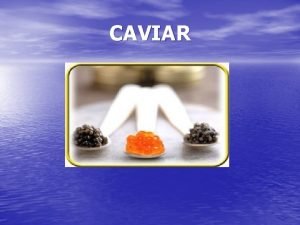STATUS OF THE CAVIAR DETECTOR AT LISE GANIL

- Slides: 1

STATUS OF THE CAVIAR DETECTOR AT LISE - GANIL L. Perrot, IPNO-IN 2 P 3 -CNRS, Orsay, France S. Grevy, C. Houarner, R. Hue, C. Marry, GANIL, Caen, France S. M. Lukyanov, Yu. Penionzhkevich , FLNR-JINR, Duban, Russia LISE spectrometer: Ligne d’Ions Supers Epluchés Locate at GANIL – Caen, France: www. ganil. fr Achromatic spectrometer build during 80’s Fundamental research in Atomic and Heavy Ions physics Various improvements: Use of degrader, Wien filter, LISE 2000 New rotating target and CAVIAR LISE 3 optic for secondary beam ± 2 RMS envelopes & Dispersion term LISE beam line and CAVIAR scheme Primary beam at target point: • ± 1. 5 mm, ± 3. 3 mrad at 2 RMS • HF CSS 2 ~12. 5 MHz LISE acceptance: • angular: ~1 m. Sr • momentum: Dp/p=2. 72% (T 16=16. 5 mm/%, Slits selection=± 45 mm) • 3 beam lines: path ~20 m & 43 m CAVIAR: Location: LISE dispersive plane Provide Br measurement, improve A/Q identification Acquisition system: • 6 modules DDM 16 (Discriminator Delay Memorization 16 Channels) R&D by GANIL • Module TGV+CENTRUM receptor in order to provide physic event association • Based on VME standard • Multi Wires Proportional Detector (R&D by FLNRJINR) • 96 wires, step=1 mm • Gas: C 4 H 10, gas unit builds by GANIL • Maximum rate per wire: 10 k. Hz • Current preamplifiers, new version Tension preamplifiers (R&D by FLNR-JINR) Detector Tuning: • Gas pressure: ~10 mbar • High voltage: ~-600 V • Threshold: ~-13 m. V • Delay time fixed with Slits at ± 0. 1 mm Need to know for A/Q identification: • Central wire of CAVIAR • Time of Flight (“Or” CAVIAR + Physic) • Br in D 31 & D 32 (analysing and refocus) • Path length (target, CAVIAR, Detection) • T 16 dispersive matrix terms of analysing and refocus sections Experimental results a-source: • Experimental set-up validation: from CAVIAR up to experiment acquisition • Study of CAVIAR contribution in the energy loss Heavy ion beam at high energy: • 78 Kr 33+ primary beam, E=70 Me. V/u • 500 mm Be target • Final focus point detector: Silicon junction • Selection slits apertures: ± 42. 5 mm Case of Kr beam is close to limit for identification for CAVIAR & LISE May 2009: 47 P synthesis experiment

